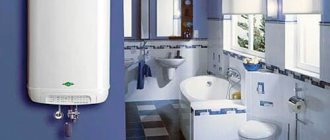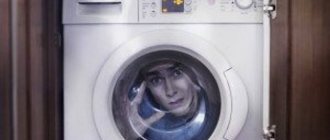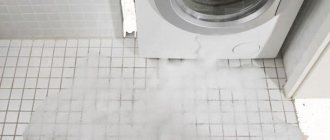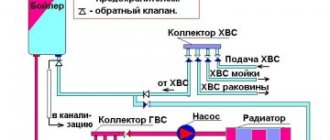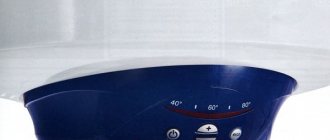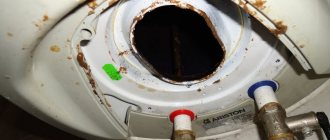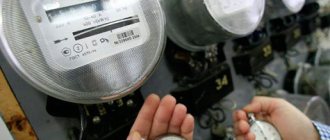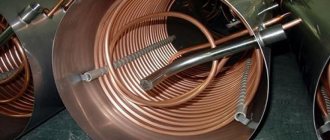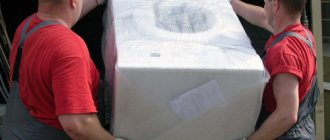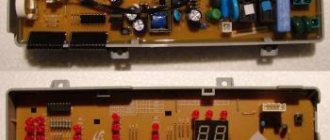Tools and materials when turning off the boiler
You can turn off the boiler on the control panel, but you won’t be able to drain the water completely.
You will need a variable-size adjustable wrench with movable jaws made of tool steel to disconnect the pipes. Use a wrench to unscrew the bolts attaching to the partition. No tool is needed if the boiler is hanging on hooks.
A hose is being prepared for the return valve or liquid inlet. Use a Phillips screwdriver to detach the safety cap. Flat-head (slotted) screwdrivers are needed to pry it up and pull it out of a tight socket.
Instructions for turning off the boiler
Before releasing the boiler, preparatory work is carried out.
- De-energize the unit. The plug is pulled out of the socket or the machine is turned off. Take an indicator screwdriver and check the presence of electricity on the contacts.
- The water supply tap in the apartment is turned off. If this is not the case, the flow of liquid is stopped by a valve in the basement.
You can empty the boiler of water only after it has cooled down. After turning off the electrics, you need to wait for the liquid to cool. Then the pipes through which water is supplied are removed from the boiler.
Long term shutdown
To prevent rust from forming inside, the boiler must be emptied of water for long periods of inactivity.
Sometimes you need to turn off the boiler for the winter and drain the water. Microorganisms multiply in liquids without heating. If the unit is located in an unheated building, the water will freeze and the boiler tank will rupture. It is recommended to turn off and dismantle the heater if the unit is to be changed or the room is decorated.
Boiler shutdown sequence:
- stop heating by turning off the heater from the network;
- turn off the cold and warm liquid supply taps going to the unit, the water will remain in the tank and will not drain;
- open the check valve on the housing.
Sometimes there is an auto-valve that provides water supply to other rooms in conditions of hard wiring.
Disconnection with dismantling
Before dismantling the boiler, unscrew the fastenings of the heating element and drain the water
The boiler must be turned off and removed from the partition. You cannot dismantle a boiler whose tank is filled with liquid inside; it must be drained to reduce the weight of the tank.
Procedure for draining and dismantling:
- close the valve on the hot tube;
- place a vessel for drainage or direct the hose into the bath;
- disconnect the junction of the cold riser and the protective hydraulic valve;
- unscrew the nut connecting the valve to the cold line fitting;
- regulate the flow by opening the valve;
- the water will go away in a few minutes.
It is not difficult to remove the unit if it is located on hooks. Dismantling requires care to avoid damaging parts.
Turning hot water off and on
The city main can start working again, then you can turn off the boiler if you have hot water. The plug is removed from the socket and the contents cool down. You can drain half the liquid and add cool to make the process faster.
To drain, close the tap on the cold pipeline and disconnect the corresponding pipe. A hose is attached to the free end and placed in the sink. The valve is unscrewed and the drain valve opens. The water mixer turns to the hot position. After this, the supply valve from the city water supply is turned on.
How to turn off the boiler: instructions
When there is no longer a need to use the boiler, it has to be turned off. To do this, you need to disconnect the device from the power supply. The further scheme for turning off the heater depends on whether it is dismantled or remains in its original place.
Disabling for a while
The first thing to do in this case is to pull the wire out of the outlet. Before doing this, be sure to set the regulator located on the instrument panel to the “Off” position. Sometimes it is necessary to disconnect the boiler from the meter. Next, close the taps in the following order:
- First, turn off the cold water tap so that it does not fill the tank.
- Open the hot water tap on the riser. After the flow of water stops, you need to check whether there is any remaining in the tank. Otherwise, you need to wait until it cools down or drain it immediately.
After these manipulations, you need to check whether there is water in the tank. This can be checked by blowing into the hose. If you hear a murmur, unscrew the fuse and open the outlet valve of the electric heater and completely drain the water.
If the heating element has a more complex design, then you cannot do without the help of a specialist. Typically, in this case, the pipes are connected to heated towel rails and other devices. They can be part of an underfloor heating system. Also, possible problems due to failed faucets, plaque deposits on the internal surfaces of faucets, and so on cannot be ruled out, which can become a serious obstacle to disconnecting the boiler from the water supply.
Before disconnecting the boiler from the network, you must turn it off
Disconnection with dismantling
To turn off the heater and then dismantle it, you will need the following tools:
- wrench;
- pliers;
- basin/bucket for draining water from the heating element.
Before removing the device, you must turn it off and remove all water from the tank. To do this, place a container under the heater to drain the liquid, unscrew the valve, and remove the hose from the tap supplying cold water. In its place, a rubber hose is put on, the end of which is lowered into a container.
If there was a temporary interruption in hot water supply
And then they gave it again - in this case you will need to turn off the device, disconnect it from the power, then drain all the water.
Long-term shutdown mechanism:
- Disconnect the device from the power source by removing the plug from the socket or by turning off the machine if an individual machine for the water heater is installed.
- If the liquid in the boiler is hot, use it up or wait until it cools down.
- Unscrew the safety valve and open the drain pan.
- In the bathroom, open the hot water faucet to allow air to flow into the boiler for normal drainage.
- Next, use a hose to drain all the liquid. When it stops flowing, check if there is any remaining in the tank.
By blowing through a hose connected to the cold water inlet of the device, if rumbling sounds are heard, the remaining water can be drained by unscrewing the heating element.
- Close the cold and hot water valves suitable for the device.
- Open the hot water tap on the riser and turn on the hot water.
How to turn off the boiler and turn on hot water
The principle here is the same as when turning on the boiler, only all steps must be done in reverse order:
- The water heater is unplugged.
- The time is maintained until the entire volume of liquid in the tank cools completely.
- Two taps are turned off - the cold water supply and the hot water outlet.
- The last thing is to open the hot water supply tap to the apartment on the riser.
The entire operation takes no more than five minutes.
There is no point in draining the water while the boiler is not in use. In water, its parts are less susceptible to corrosion. It is better to drain the water before putting the device back into operation, rinse it and fill it with clean water.
If you need to drain the water, this can be done using a check valve installed on the water heater.
So, connecting and disconnecting the boiler is quite simple, you just need to understand why certain actions are being performed. The connection and disconnection diagrams for Termex, Ariston, Electrolux and others boilers are absolutely identical.
The stores offer a huge selection of water heaters and boilers, but not everyone knows about all the capabilities of this equipment. In order not to get confused in the choice, you need to know the basic criteria by which you should purchase a device. You will learn how to choose a storage water heater for an apartment on our website.
Whether it is necessary to drain water from a water heater and how to do it correctly, read this topic.
Turning off the boiler at night
If you use hot water in the morning, it will, of course, not be convenient for you to get up 2 hours in advance to heat it, so whether you need to turn off the boiler is up to you, but it would be more logical to leave it in operating mode. If there is no urgent need for it in the morning, then turn off the power to the device to save electricity.
Let's look at how to do this using the following models as an example: Termex, Ariston, Electrolux. On mechanically controlled units, you will need to move the water heating adjustment toggle switch to the extreme left position, turn off the power button, and, of course, unplug from the outlet.
If you have an electronically controlled device, everything is still much simpler. Just press the OFF button on the control panel and disconnect from the power supply, and if you have a separate automatic machine installed on the heating device, turn it off.
If you have a storage water heater with a timer, you can set the time in the evening and receive heated water in the morning. The most popular model with this function is Thermex 1D 50V.
However, in this model, users are faced with the problem of “demo mode”: the heating device is turned on, the temperature is set, however, cold liquid still flows from the tap. Disabling demo mode is very simple - you need to simultaneously press the up and down arrows on the display and hold them for about two to three seconds.
When the boiler is turned off
The electric heater is turned off for several reasons:
- seasonal interruptions in the supply of bitter water from the central water supply system;
- lack of running hot water;
- leaving for a long time;
- heater failure.
Let's look at each situation separately. The procedure for connecting/disconnecting the boiler is specified in the instructions for the device. Here we will look at detailed recommendations for turning off the power to your water heater yourself.
Shutdown for water supply from local water supply
In the case when the boiler was used after turning off the supply of hot water from the hot water supply, it is turned off as there is no need. The following algorithm applies to this process:
- disconnect from the power supply by turning the switch on the boiler control panel to the “Off” position;
- pull out the plug from the socket and/or disconnect the device from the meter;
- drain the water;
- turn off the cold tap and disconnect the hose from it;
- open the drain valve and remove any remaining water from the tank;
- turn the mixer to the hot position;
- shut off the cold and hot flows and open the water valve on the riser.
The water heater is disconnected not only from the network, but also from the meter, if required.
Nighttime shutdown
If the user does not intend to use hot water at night, then the boiler should be de-energized mainly to save electricity. However, the next day you will have to wait several hours for the required volume of water to warm up.
So, in this case, you can turn off the heating element as follows:
- electric storage heaters, for example, Ariston, are turned off by turning the switch to the extreme position counterclockwise.
- After setting the regulator to the “Off” position, the device is disconnected from the electrical network by removing the plug from the socket.
- If the boiler has a timer, then it can be set for the required time, during which the device will heat water, and after which it will turn off.
For the winter
Is it possible to leave a tank filled with liquid for such a long period? The prescribed operating instructions do not recommend leaving the water heater filled with liquid for such a long period of time.
Since stagnation occurs, bacteria multiply, metal oxidation and destruction of the inner surface of the tank, which significantly reduces the service life of the boiler. It is necessary to disconnect it from the network and drain the water.
Video on how to drain water from a boiler:
Water heater in the house: convenience or problems?
Hot water in the house is, of course, a blessing. Not so long ago, a widespread centralized supply of hot water was planned. Personal water heaters were considered an anachronism. But the situation has changed dramatically since the moment when the issue of energy saving arose. This time coincided with a construction boom. In a private cottage it is much easier and more convenient to have your own hot water supply system. It will not turn off in the summer and will always give the desired temperature.
Implementing the decision to install an autonomous hot water supply system requires some preparation, since water heaters are quite complex and very expensive units. When choosing a specific model, many factors need to be taken into account. The answers to most questions are contained in the operating instructions. But life often creates non-standard situations that require the same non-standard solutions. Let's try to find answers to unexpected questions.
It all depends on the specific situation. If a family with children lives in a country house, especially if they are small and the mother spends all the time with them, then hot water is needed constantly. Moreover, a constant reserve is needed so that interruptions in the water supply do not lead to dirty children running around the house.
In these conditions, the optimal solution would be to install a storage water heater. It’s another matter if, after the morning toilet and shower, the whole family scatters to work, schools and kindergartens. In this case, the water in the storage heater tank becomes uselessly cold, and maintaining its temperature until the evening will be too expensive.
With such rules of family life, it would be more correct to use an instantaneous water heater.
Is it possible to use one water heater for several distribution points?
Yes, it is possible if it is provided for by the design. Usually this feature is indicated in a separate paragraph in the instruction manual. If there is no such indication, then, by default, the water heater is intended for one water collection point. What happens if more taps are connected to it? Nothing special, it will just heat poorly, switch off frequently and quickly fail.
Instructions for starting the boiler for the first time
The boiler is installed. Whether the installation work was carried out by specialists or the owner does not matter. In any case, you need to check the operation of the system. To do this, following the given tips, you need to start the heater for the first time.
- We start by checking the correct connection of the systems that are responsible for heating the water. Fidelity, reliability of connection of phase and neutral wires, presence of grounding. The functionality of the circuit breaker should also be checked. To do this, use a device - a tester or a special electrician's screwdriver.
- Next comes the search for leaks in the system . It would be useful to control the connection of underwater pipes. Presence and diagnostics of check valve operation.
- Running water into the boiler . Attention, the correct sequence of actions for the first and subsequent starts of the system will be described in the next section.
- Repeated search for water leaks in pipe installation areas b.
- Diagnostics of heater operation . Turn on the device by pressing the power button.
- Fixing the initial temperature sensor readings.
- Re-check after 15 minutes . An increase in indicators indicates the correct connection of the heating elements.
Checking the health of the equipment
In order to check how well the water heating device works after a break in operation, it is necessary to record the initial temperature readings on the device and compare them with the temperature 15-20 minutes after switching on. If the temperature rises, it means the water is heating up and the boiler is working properly.
Go to the catalog to view all water heatersGo to the catalog
Important! Since the water heating device has high power, a separate RCD should be installed on the boiler.
After turning on the water heating equipment, you also need to check the pipes for leaks. They happen due to the fact that the gaskets in the pipes do not always withstand the water pressure in the water heater, which is usually an order of magnitude higher than in the riser.
If, when you turn on water heating equipment that has not been in use for a long time, your plugs are knocked out, try starting again. Re-disabling the automatic starter requires consultation with a specialist.
How to turn on the boiler?
The working diagram of the boiler is that cold water is poured into the tank, heated and transferred through a hot water pipe. Therefore, when installing a water heater, a cold and hot water supply is provided. So, let's do everything in order:
- First, close the hot water tap along the riser, this is to prevent already warm water from leaving the water heater into the riser.
- Second, turn on the hot water faucet, drain the remaining water and check that no water is flowing.
- Third - Open the cold and hot water taps, those connected to the boiler.
- Plug in the water heater. Select the required program and put the boiler into operation.
- Fourth - Be careful! After you turn on the boiler, be sure to check the hot water pipe for leaks. Since the water pressure in the water heater is higher than in the riser, and if, suddenly, the gaskets are weaker, then there may not be a leak when the water comes from the riser, and when a boiler is used, the gaskets cannot always withstand.
Turning on the water heater without water
Many users are concerned about what to do if they turn on the boiler without water. If you forget to fill the boiler tank with water when you turn it on, it will not turn off automatically. The temperature sensor will detect the air temperature in the room (20-25 degrees), take this indicator as the water temperature and will not recognize errors. What will happen? The most unpleasant consequence of the lack of water in the water heater can be the burnout of the heating element. If such a breakdown occurs, it is unlikely to be repaired even under warranty.
Draining water from the boiler for the winter - Ariston, Termex and other options with video
Boilers are an excellent solution for those houses and apartments that do not have a centralized hot water supply. Such devices provide residents with warm water around the clock and do not require complex maintenance. Only occasionally do you have to drain the water from the boilers and clean the containers from the sediment that has formed.
Briefly about the boiler design
Before you start draining the water, you should study the structure, design features and operating principle of the boiler. Such information is usually contained in the instructions for the water heater . Let's take a closer look at what a boiler is and how it works.
The main structural part of the boiler is a storage tank made of metal: stainless steel or ordinary steel with an enamel coating applied to it. The tank is equipped with two tubes, an air vent and an electric heater. To ensure that the water in the tank maintains a high temperature for a long time, the tank is insulated with a layer of thermal insulating material. This entire structure is enclosed in a common housing, and in order for the boiler to operate in automatic mode, the device is additionally equipped with a thermostat.
Boilers come in different capacities. Small water heaters, as a rule, do not have a drain hole, and water is supplied from above. Draining water from such a container is quite simple; you just need to remove the tank and turn it over .
Advice: when choosing a water heater with a small volume, evaluate the ease of use of the device and give preference to those models from which it will be easy to drain water.
Large boilers are often equipped with a drain hole, but emptying such heaters is more difficult than in the case described above. If you simply close off the access of cold water to the container, and then open the tap to drain the hot water, the liquid will not flow out completely, but only to the level where the highest point of the hot water supply tube is located. The water can be completely drained only if air gets inside the boiler . To empty large water heaters, the inlet and outlet openings of the structure are equipped with tees with taps.
Schematic representation of the internal structure of the boiler
Why do you need to drain the water and when is the best time to do it?
Water from the boiler must be drained in the following cases:
- If the water heater is located in an unheated area, the tank must be emptied before winter arrives. With the onset of frost, the liquid will begin to turn into ice and increase in volume, which can lead to serious damage to the device and loss of its functionality.
- If the warranty period for the boiler has expired, and the structure needs to be repaired or the magnesium anode replaced, the water must also be drained. All such procedures are carried out only with a dry and clean tank. It is worth noting that during the warranty period you cannot carry out repairs yourself, otherwise the warranty will become invalid.
- At least once every 5 years, the water heater must be descaled. If the water supplied to the tank is not of good quality, it is advisable to carry out a similar procedure more often. The sediment that remains in the tank interferes with the rapid heating of water, which means that the boiler consumes more electricity to operate.
Now I would like to consider cases when there is no need to drain water from the boiler:
- When turning off the water heater during the warm season, it is not recommended to drain all the liquid from the tank. If the device is not threatened by frost, it is better to leave some water in the container - this will protect the interior of the tank from corrosion. In addition, if, out of forgetfulness, you plug in an empty boiler, a fire hazard may arise .
- If the device has been left unplugged for some time and the water in it has stagnated, it is also not worthwhile to completely empty the container. Stale water simply needs to be refreshed by filling the tank full several times. It is advisable to repeat this procedure every 3 months, running 100 liters of cold water through the heater.
- If the unit is still covered by the warranty, it is highly not recommended to drain the water, much less repair any parts yourself. In such a case, the warranty will become void. If problems arise with the boiler, it is better to simply call qualified specialists. They will drain the water themselves, fix the breakdowns and do it for free.
Sequencing
It’s worth mentioning right away that the startup sequence below is correct for both flow-through and storage heaters . A couple of nuances - in the case of the first type, you do not have to wait for the tank to be filled with water and close the tap at the 2nd point.
- You should start by turning off the hot water supply , which comes from the city supply system. If you skip this step, the water heated by the boiler will go into the common riser, despite the check valve.
- Open the hot water tap . We wait until the remaining liquid drains from the pipes. Close the tap.
- Two pipes go to the bottom of the boiler. One, marked with a blue ring, is underwater, the other, with a red marker, serves to supply hot water to the pipes .
- Open the valve on the underwater pipe . Water begins to flow into the device’s storage tank.
- Next, unscrew the second valve on the boiler . Allowing the water to escape into the pipes.
- Open hot water on the mixer . We wait until the air leaves the system and a steady stream of water flows. We turn off the water.
- We connect the heater to the electrical network and set the desired temperature.
In a house where there is no hot water supply, the first step must be skipped. Subsequent switching on of the heater will follow the same pattern. The only difference is in point 6. Then not air, but stagnant water will begin to come out of the heater tank.
Heating mode selection
Set the heating mode. The main thing in this matter is to set the water temperature that is comfortable for the user . However, here are a few tips, the implementation of which will significantly extend the service life of the device. This will save you money on future repairs.
- Set the temperature to 30–40 degrees as little as possible . Under such conditions, bacteria will quickly develop inside the storage tank. This will result in an unpleasant musty odor. The walls will become covered with fungus, which is difficult to remove.
- Optimal operating mode, 55–60 degrees . In this temperature range, less scale will form on the heating element. The risk of mold will be reduced. It is comfortable for human skin.
- Once a week the boiler must be set to 90 degrees . Wait a couple of hours and return to the previous mode. This is done to completely destroy bacteria in the storage tank.
- Some devices have an economical operating mode. In this case, the heater does not consume less electricity. The settings will be set as in point 2 and we are talking about reducing the risk of breakdown.
- In the case of a flow-type heater, the temperature is also adjusted by water pressure.
What are the consequences of excess moisture in the soil?
You can see the results of this phenomenon yourself - trees and shrubs die. Why is this happening?
- the oxygen content in the soil decreases and the carbon dioxide content increases, which leads to disruption of air exchange processes, water regime and nutritional regime in the soil;
- oxygen starvation of the root-forming layer occurs, which leads to the death of plant roots;
- the supply of macro and microelements by plants (nitrogen, phosphorus, potassium, etc.) is disrupted, because excess water washes out mobile forms of elements from the soil, and they become unavailable for absorption;
- intensive breakdown of proteins occurs and, accordingly, the processes of decay are activated.
Plants can tell you at what level groundwater lies
Take a close look at the flora of your area. The species inhabiting it will tell you at what depth the groundwater layers are located:
- perched water - it is best to dig a reservoir in this place;
- at a depth of up to 0.5 m - marigold, horsetails, varieties of sedges grow - bladderwrack, holly, foxtail, Langsdorff's reed;
- at a depth of 0.5 m to 1 m - meadowsweet, canary grass, ;
- from 1 m to 1.5 m – favorable conditions for meadow fescue, bluegrass, mouse peas, rank;
- from 1.5 m - wheatgrass, clover, wormwood, plantain.
What is important to know when planning site drainage
Each group of plants has its own moisture needs:
- with a groundwater depth of 0.5 to 1 m, vegetables and annual flowers can grow in high beds;
- depth of water layer up to 1.5 m is well tolerated by vegetables, grains, annuals and perennials (flowers), ornamental and fruit shrubs, trees on a dwarf rootstock;
- if the groundwater is more than 2 m deep, fruit trees can be grown;
- The optimal depth of groundwater for agriculture is from 3.5 m.
Is site drainage necessary?
Record your observations for at least some time. You yourself can understand how much drainage is needed.
Maybe it makes sense to simply redirect melt and sediment water along the bypass channel, rather than allowing it to flow through your site?
Perhaps it is necessary to design and equip a storm drain and improve the composition of the soil and this will be enough?
Or is it worth making a drainage system only for fruit and ornamental trees?
A specialist will give you the exact answer, and we strongly recommend calling him. But after reading this article, you will gain some awareness on this issue.
Upon completion of the technological and production tasks associated with the arrangement of a sewer system in an apartment building, industrial building, as well as in a private household, it is necessary to test the involved system using the forced flow method. This task is used to identify possible defects or improper installation of the entire involved sewerage part, and the test report for internal sewerage and drainage systems will be material evidence of the work on acceptance of the facility.
A visual inspection should be accompanied by inclusion in the test report of internal sewerage and drainage systems according to SNIP, which is currently represented by the current regulations of the “D” series appendix, which corresponds to SP 73.13330.2012 “Internal sanitary systems of a building”, recently a new one has been applied updated working edition according to SNiP 3.05.01-85.
Rules for using the device
You can use the storage type device immediately after the first start. To do this, you need to turn it on and select the operating mode. Throughout operation you will have to follow some rules. They will help increase the service life of the boiler.
- Before turning on, check the presence of water in the tank . This will prevent the heating elements from failing.
- It is recommended to install a filter on the pipe supplying water to the boiler . It will protect against dirt and reduce water hardness.
- During the year, descale the drive at least once.
- Periodically monitor the performance of the protective anode , change if necessary.
Read here how to choose pipes for water supply in a private house.
PVC pipes and fittings for water supply are the key to quality water in the house, read about the benefits.
Flow-type devices require compliance with several other rules.
- Before turning on the power, check the water pressure . A weak stream will not allow the device to function normally.
- If the temperature is uncomfortable, adjust it using the buttons on the body or by rotating the mixer tap.
- If the heater is installed in a bathroom, provide splash protection .
- Hot water is no longer needed - be sure to turn off the device.
Both devices are not recommended for installation in rooms where temperatures may drop below zero. This will cause the water inside the device to freeze and cause it to break.
Equipment reliability depends not only on product quality. Also important: correct installation, switching on and use of equipment. Compliance with the recommendations given in the article will significantly increase the uninterrupted operation of the boiler.
Boiler prevention and maintenance
It is necessary to carry out preventive measures after approximately one year of its operation.
The magnesium anode rod in the boiler will have to be replaced as necessary (its service life is usually indicated in the user manual). This rod protects the heating element of the heater and extends its service life.
The boiler requires periodic cleaning from the deposits of salts accumulated inside the tank
If there is hard water in the water supply system, then the tank needs frequent descaling.
A signal to start cleaning the device may be an increase in the water heating time and the appearance of unusual sounds. Sometimes it is possible for the boiler to automatically turn off due to a large amount of scale on the heater.
There are two ways to remove salt deposits on heating elements - mechanically and chemically. The first is to clean with a metal brush or knife, but only if the heating element is wet. The second is carried out using special household chemicals. You can do this with vinegar essence. It is diluted in a bucket of water and heated on the stove.
Mechanical descaling of the heater must be done while it is wet.
To clean the tank itself, use solutions of baking soda and laundry soap. After completing the cleaning, it is recommended to pour one and a half liters of table vinegar into the tank to consolidate the effect.
Video: cleaning the heating element
Tips for choosing a heating mode
It is generally accepted that low heating temperatures save electrical energy. However, this opinion is erroneous. When this function is turned on, the efficiency of the water heater decreases sharply. As a rule, modern boilers are equipped with a special function that allows you to save energy. You can turn it on by pressing the corresponding button on the instrument panel.
Economy mode does not allow the heater to exceed the 50 degree limit. In this case, virtually no scale forms inside the device.
Important! If the water heating temperature is less than 50 degrees, bacteria will begin to multiply in the boiler. Thus, the water quality will deteriorate.
Do I need to drain the water?
Usually the remaining water in the boiler is not drained. It remains in the water heater until the next time it is turned on, provided that the period of inactivity is short. If you turn off the boiler for several weeks or months, the water must be drained. Otherwise, oxidation or scale formation may occur, which will shorten the service life of water heating equipment.
It is necessary to drain the water after the boiler is disconnected from the power supply in poorly heated housing. In a home with low temperatures, water can freeze and rupture the water heater. To eliminate any remaining water, you should use a check valve. It is located on the equipment body.
What to do if the boiler produces less hot water
Don't worry if you notice that your heater is producing less hot water than usual. If you decide to use a water heater (boiler) during the cold season, please note that the temperature of the water entering the water heater tank is significantly lower than in other seasons. Thus, the time required for heating increases, and accordingly, your waiting time also increases.
Another reason for a decrease in the amount of hot water may be an unclosed riser. If you don't screw the faucet tightly and don't turn off the water, then all the neighbors in your house will also be able to enjoy a hot bath. Therefore, it is better to once again check how tightly the tap is closed, and whether the water supply is turned off.
What to do if the thermometer on the boiler does not work
The main function of the heater temperature indicator is to control the water temperature.
As soon as the water reaches the specified parameters, the temperature sensor is triggered, sending a signal to the control module. It does not show the exact temperature; its main task is to convey the degree of heating of the liquid. If you have just started using a water heater to heat water and observe strong errors: the indicator shows that the temperature is low, and boiling water is pouring from the mixer, then it is better to contact a specialist.
What to do if the safety valve is leaking
The safety valve has an important function; it corrects the operation of the entire water heater. When water is heated, it increases in volume, which creates increased pressure in the boiler; when this pressure begins to exceed the permissible limit, the spring in the safety valve compresses and opens it. Excess fluid is released, then the pressure returns to normal. A “leaking” water heater safety valve is actually evidence that it is working correctly. During the heating process, up to one and a half liters of liquid can leak from the safety valve.
If the valve leaks when the device is turned off, it is necessary to install a pressure reducer, since the pressure of your network exceeds the permissible atmosphere value 4.
What to do if the water in the boiler has an unpleasant odor
If you do not use the water heater regularly, the liquid in the boiler may stagnate and an unpleasant odor may appear. Stagnant water is a favorable environment for the active proliferation of bacteria; their vital activity is a source of rotten odor.
In order to get rid of an unpleasant odor, you need to take the following measures:
- completely drain the stagnant liquid from the boiler;
- fill the tank with clean water;
- set the maximum heating value;
- leave the boiler on for a couple of hours;
- Drain the heated water and refill the tank.
After this procedure, the unpleasant odor will disappear.
In addition to bacteria, the materials from which the device is made can become a source of unpleasant odors. If you use a water heater made from low-quality plastic, then during the heating process the plastic will begin to release harmful substances such as formaldehyde or phenol. As a result, the heated liquid will smell like medicine. Unfortunately, to solve this problem it is necessary to replace the device. Filters will not be able to purify water from formaldehyde compounds.
